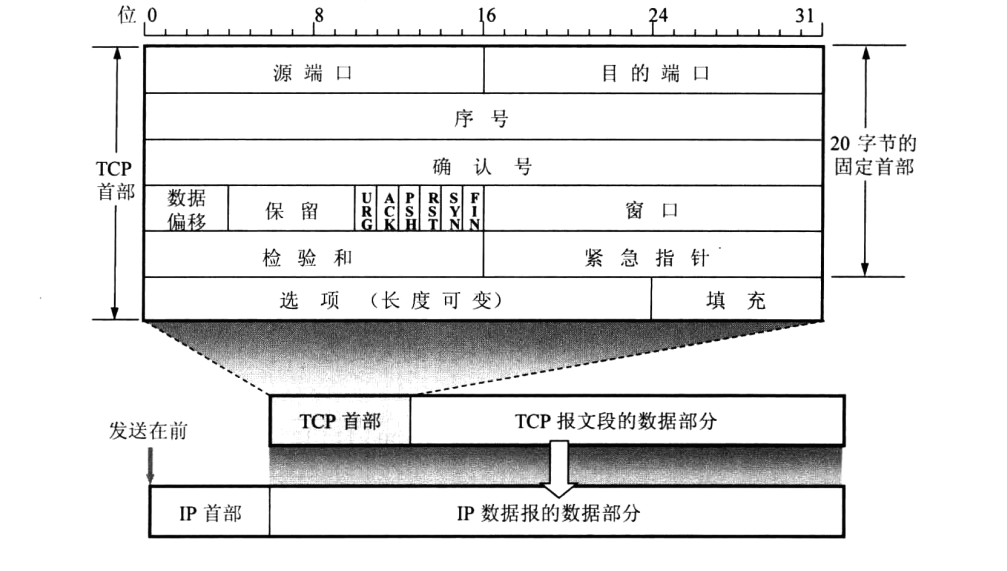CS144-lab1
cs144-lab1:
lab1 开始有那么点麻烦了...需要阅读理解封装好的模块。
配置环境:
记得做前将代码与之前 lab0 合并一下即可,至于 debug ,本地的所有测试都在 build 中,挨着测试即可。
由于握手环节需要 cmu 的内部网络,所以跳过, ip-raw.cc 我就没有去实现。
以下是 lab1 的实践内容:
作为实验作业的一部分,你正在实现一个 TCP 接收器:该模块接收数据报并将其转换为可靠的字节流,以便应用程序可以从套接字中读取——就像你的 webget 程序在检查点 0 中从 web 服务器读取字节流一样。
TCP 发送器将其字节流划分为短段(每个段不超过约 1,460 字节)以便它们可以放入数据报中。但是,网络可能会重新排序这些数据报,或者丢弃它们,或者多次投递它们。接收器必须将这些段重新组装成它们最初开始的连续字节流。
在这个实验室中,您将编写负责此重组的数据结构:一个重组器。它将接收子字符串,由字节字符串组成,以及该字符串中第一个字节的索引,该索引位于更大的流中。流中的每个字节都有自己的唯一索引,从零开始向上计数。一旦重组器知道流中的下一个字节,它就会将其写入 ByteStream 的写入端——与您在检查点 0 中实现的相同的 ByteStream。重组器的“客户”可以从同一 ByteStream 的读取端读取。
其实我们就是在这里是在实现 tcp 的重组部分,需要联系上一个 lab0 中的 byte_stream 内容。在此之前,或许回顾一下 tcp 的报文结构有助于我们实现 lab1。

而这里面与我们要实现的 Reassembler 相关联最大的两个字段就是
序列号 (Sequence Number)
- 位置:TCP 头部的前 32 位。
- 作用:序列号标识了数据段在整个数据流中的位置。发送端为每个数据段分配一个序列号,接收端根据序列号对数据进行排序和重组。如果数据包乱序到达,接收端会利用序列号重新排列它们。
- 重组相关性:这是重组的核心字段,确保数据按顺序拼接。
确认号 (Acknowledgment Number)
- 位置:TCP 头部的第 33-64 位。
- 作用:确认号表示接收端期望接收的下一个字节的序列号。它用于确认已经成功接收的数据,帮助发送端知道哪些数据需要重传。
- 重组相关性:通过确认号,接收端可以间接通知发送端是否存在丢失的数据包,从而辅助重组过程。
如果对于 tcp 不够熟悉,可以阅读这一篇 blog,或者看一看黑书的 tcp 部分也不错。
而我们则需要根据序列号与确认号来构建 Reassembler。
Reassembler:
因为我们的数据包有着对应的编号,也就是模拟我们之前提到的序列号,我们可以使用有序键值对类似 map 或者 set 来实现,我采用的是 map。除此之外,我们需要维护一个 next-index(这里的 next _index 即可理解为对应的确认号)来作为重叠以及是否丢包等的判断依据。(做完 lab2 发现这样理解似乎有点问题,但在做 lab1 本身时也能凑合...)
构造之前一定先阅读 byte_stream_helper ,明白 byte_stream 是如何调用内部派生的 writer 和 reader 接口的。理解 output_.writer() 和 output_.reader() 其实是转换出了对应的派生类。避免了多重继承复杂性,非常优雅,但是对于 c艹 掌握不好的人来说是一种痛苦...
#include "byte_stream.hh"
class Reassembler
{
public:
// 构建Reassembler以写入给定的ByteStream。
explicit Reassembler( ByteStream&& output ) :
output_( std::move( output ) ),
pending_data(),
next_index(0),
eof_index(0),
eof_rec(false){}
/*
* 插入一个新的子字符串以重新组装到ByteStream中。
* `first_index`: 子字符串的第一个字节的索引
* `data`: 子字符串本身
* `is_last_substring`: 此子字符串表示流的结束
* `output`: 对Writer的可变引用
*
* Reassembler的任务是将索引的子字符串(可能是乱序或重叠的)重新组装回原始的ByteStream。
* 一旦Reassembler知道流中的下一个字节,它应该立即将其写入输出。
*
* 如果Reassembler了解到字节适合流的可用容量但还不能写入(因为前面的字节仍然未知),
* 它应该将它们存储在内部,直到填补了空缺。
*
* Reassembler应该丢弃任何超出流可用容量的字节
* (即即使前面的空缺被填补也无法写入的字节)。
*
* Reassembler在写入最后一个字节后应关闭流。
*/
void insert( uint64_t first_index, std::string data, bool is_last_substring );
// Reassembler本身存储了多少字节?
// 此函数仅用于测试;不要为了支持它而添加额外的状态。
uint64_t count_bytes_pending() const;
// 访问输出流读取器
Reader& reader() { return output_.reader(); }
const Reader& reader() const { return output_.reader(); }
// 访问输出流写入器,但仅为const(不能从外部写入)
const Writer& writer() const { return output_.writer(); }
private:
ByteStream output_;
std::map<uint64_t, std::string> pending_data;// 存储数据的映射
uint64_t next_index = 0; // 下一个索引
uint64_t eof_index = 0;
bool eof_rec = false;
};
对于重组器的设置,我们需要考虑到以下因素。
- 乱序: 缓存并排序。
- 丢失: 请求重传。
- 重复: 丢弃冗余。
- 重叠: 裁剪多余。
- 大小异常: 截断或丢弃。
- 中断: 停止重组。
不过在 lab1 中我们不用考虑这么全面,只需要考虑其中的一部分。
而在这里我们需要考虑的是5个值构建出来的区域:
uint64_t first_index;
uint64_t len = data.size();
uint64_t next_index;
uint64_t count = count_bytes_pending();
uint64_t available = output_.writer().available_capacity();
实现:
分析实验指导书上给出的示意图:

于是整个 lab1 中象征存储的部分其实有三个,因为我们在 Reassembler 中并没有涉及到 pop 相关的操作:
//两个依据 bytestream 中定义构建出来的数据
total_capacity = output_.writer().available_capacity() + output_.reader().bytes_buffered();
available_space = output_.writer().available_capacity();
//以及我们定义的 pending_data 用来存储还没 push 到 writer 中的值
pending_data所以对于我们需要满足以上的所有逻辑,比如对于 available_space ,其实模拟的是我们的接收窗口 rwnd:
// 如果缓冲区已满,不存储任何未来数据,直接返回
if (available_space == 0) {
return;
}按照道理来说,我们应该可以存储在 pending_data 中,但实际上,我们需要模仿 tcp 的流量控制,所以不能存储。
TCP流量控制原理
在TCP协议中,接收窗口(receive window)是一个关键概念:
- 接收窗口大小表示接收方当前愿意接收的数据量
- 当接收窗口为0时,发送方必须停止发送数据
- 只有当接收方处理了一些数据并增加了窗口大小,发送方才能继续发送
同样的,我们也需要遵循存储限制:
if (new_index > next_index && new_index - next_index + len > total_capacity) {
if (new_index - next_index >= total_capacity) {
return; // 确实超出范围才返回
}细节:
整个流中第一个字节的索引是多少?Zero.
指导书上简化了我们对于重组的处理,由于第一个传来的是0,而我们默认一定会将其推送出去。比较明显的是,next_index 应该在我们能连续处理数据时才更新。
之后的动作均是检查存储空间是否足够,足够便推送,不够就丢弃的思维来写,需要仔细考虑的部分就是重叠该如何处理,如果有很多重叠数据的话可能会造成很多内存浪费。
完整代码如下:
#include "reassembler.hh"
#include "debug.hh"
using namespace std;
void Reassembler::insert(uint64_t first_index, string data, bool is_last_substring)
{
debug("unimplemented insert({}, {}, {}) called", first_index, data, is_last_substring);
// 先检查索引是否在合理范围内
// 如果first_index大于当前索引加上可用容量,直接丢弃
if (first_index > next_index + output_.writer().available_capacity()) {
// 只处理is_last_substring标志
if (is_last_substring) {
eof_rec = true;
eof_index = first_index + data.size();
if (next_index >= eof_index) {
output_.writer().close();
}
}
return; // 直接返回,不存储数据
}
// note: 一定先判断发过来的字节流类型,以及是否是最后一串字节流
if (data.empty()) {
if (is_last_substring) {
eof_rec = true;
eof_index = first_index;
if (next_index >= eof_index) {
output_.writer().close();
}
}
return;
}
uint64_t len = data.size();
// 处理EOF标记
if (is_last_substring) {
eof_rec = true;
eof_index = first_index + len;
if (next_index >= eof_index) {
output_.writer().close();
}
}
// 获取可处理的容量限制
uint64_t total_capacity = output_.writer().available_capacity() + output_.reader().bytes_buffered();
uint64_t available_space = output_.writer().available_capacity();
// 如果缓冲区已满,不存储任何未来数据,直接返回
if (available_space == 0) {
return;
}
/* note:数据重叠处理是最复杂的部分,因为都避免重复状态,所以都细致思考*/
// 处理数据重叠部分 - 先处理与前面数据的重叠
uint64_t new_index = first_index;
// 如果起始位置在已处理数据之前,调整起始位置
if (first_index < next_index) {
// 完全重叠,直接丢弃
if (first_index + len <= next_index) {
return;
}
// 部分重叠,截取未处理部分
uint64_t offset = next_index - first_index;
data = data.substr(offset);
new_index = next_index;
len = data.size();
}
// 检查重叠情况 - 与pending_data中已有数据比较
auto upper_bound = pending_data.upper_bound(new_index);
if (upper_bound != pending_data.begin()) {
auto prev = upper_bound;
--prev;
// 检查与前一个片段的重叠
if (prev->first <= new_index && new_index < prev->first + prev->second.size()) {
// 有重叠,调整起始位置
uint64_t overlap = prev->first + prev->second.size() - new_index;
if (overlap >= len) {
// 完全被包含,丢弃
return;
}
data = data.substr(overlap);
new_index += overlap;
len = data.size();
}
}
// 处理与后续片段的重叠
auto it = pending_data.lower_bound(new_index);
while (it != pending_data.end() && new_index + len > it->first) {
if (it->first < new_index + len) {
if (new_index + len >= it->first + it->second.size()) {
// 当前数据完全覆盖了这个片段
pending_data.erase(it++);
} else {
// 部分重叠,截断当前数据
len = it->first - new_index;
data = data.substr(0, len);
break;
}
} else {
break;
}
}
// 检查是否超出总容量限制
if (new_index > next_index && new_index - next_index + len > total_capacity) {
if (new_index - next_index >= total_capacity) {
return; // 确实超出范围才返回
}
uint64_t available = total_capacity - (new_index - next_index);
data = data.substr(0, available);
len = data.size();
}
// 处理数据写入
if (new_index == next_index) {
// 检查可用容量
if (available_space >= len) {
// 有足够容量,直接写入
output_.writer().push(data);
next_index += len;
} else {
// 容量不足,只写入能写入的部分,剩余部分丢弃
string write_data = data.substr(0, available_space);
output_.writer().push(write_data);
next_index += available_space;
// 不存储剩余部分到pending_data
}
// 查找并处理后续连续片段
bool found_next = true;
while (!pending_data.empty() && found_next && output_.writer().available_capacity() > 0) {
found_next = false;
auto next_it = pending_data.find(next_index);
if (next_it != pending_data.end()) {
// 检查可用容量
uint64_t avail = output_.writer().available_capacity();
string pending_data_str = next_it->second;
if (avail >= pending_data_str.size()) {
// 能全部写入
output_.writer().push(pending_data_str);
next_index += pending_data_str.size();
pending_data.erase(next_it);
found_next = true;
} else if (avail > 0) {
// 只能部分写入,剩余部分丢弃
string write_part = pending_data_str.substr(0, avail);
output_.writer().push(write_part);
next_index += avail;
pending_data.erase(next_it);
// 不存储剩余部分
break;
} else {
break;
}
}
}
} else if (!data.empty() && new_index > next_index) {
// 确保new_index与next_index之间的距离加上数据长度不超过总容量
if (new_index - next_index + len <= total_capacity && available_space > 0) {
// 存入pending_data
pending_data[new_index] = data;
}
// 否则丢弃数据
}
// 检查是否需要关闭流
if (eof_rec && next_index >= eof_index) {
output_.writer().close();
}
return;
}
uint64_t Reassembler::count_bytes_pending() const
{
debug("unimplemented count_bytes_pending() called");
uint64_t count = 0;
for (const auto& pair : pending_data) {
count += pair.second.size();
}
return count;
}测试结果:
可以看到测试还算不错。不过由于没有做模块化处理,可能会显得有些赘余,俗称💩山。
